Abstract
Ten porcine enteroviruses, 2 porcine adenoviruses and 1 coronavirus were isolated directly from 32 samples of slurry collected from a pig fattening house. Concentration of the same samples by adsorption with the polyelectrolyte PE-60 yielded 24 porcine enteroviruses and 3 porcine adenoviruses. A porcine enterovirus was isolated, following PE-60 concentration, from 1 to 6 slurry samples from a sow farrowing house. No virus was isolated from 12 samples of slurry from dairy cows nor from 6 slurry samples from a calf-rearing unit. A porcine enterovirus was isolated from soil samples, after concentration with PE-60, collected 1, 2 and 8 days after pig slurry was spread on hay stubble. Two porcine enteroviruses were isolated by membrane filtration from 26 samples of surface run-off from land on which pig slurry was routinely spread, and 2 bovine enteroviruses were isolated from cattle feedlot run-off after adsorption to layers of talc and celite followed by hydroextraction. A porcine enterovirus was also isolated from 1 of 33 samples of surface water collected on farms on which pig slurry was routinely spread on the land, but no virus was isolated from 36 samples of ground water from the same farms. The surface water and ground water samples were concentrated by talc-celite adsorption and hydroextraction.
Full text
PDF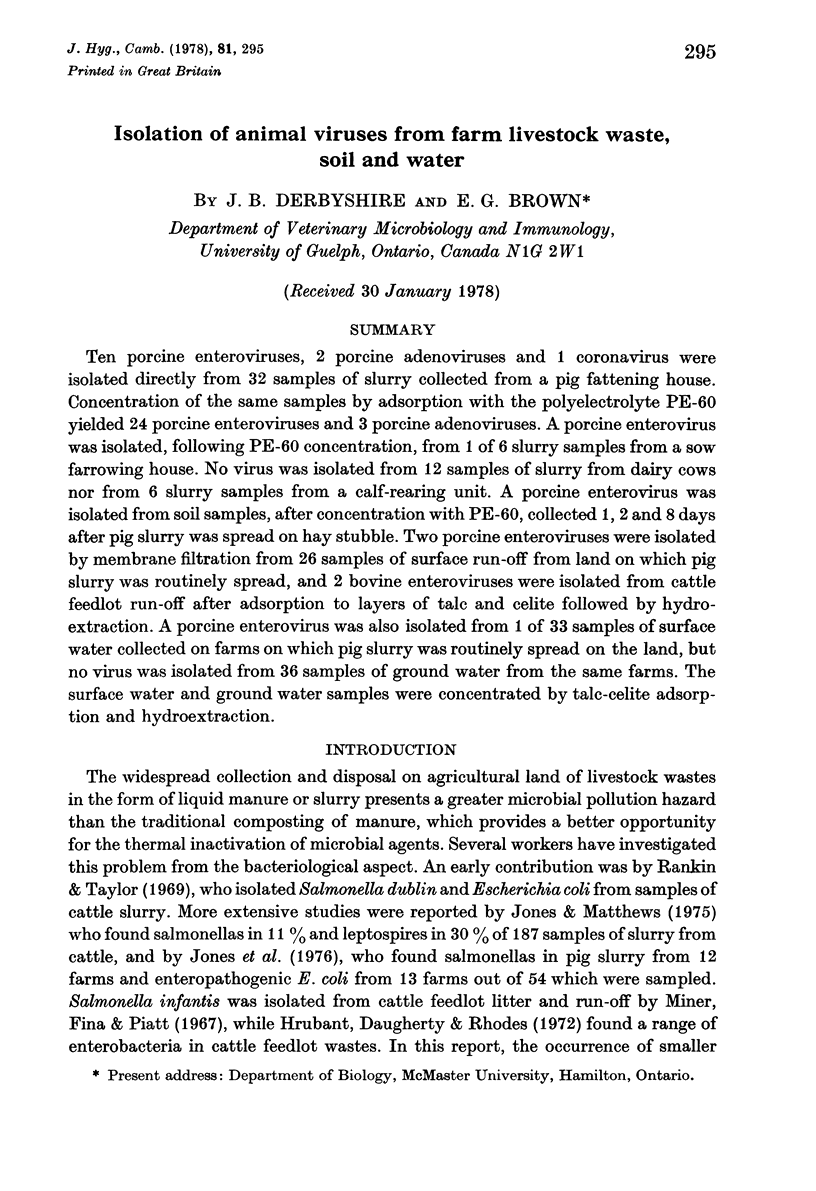
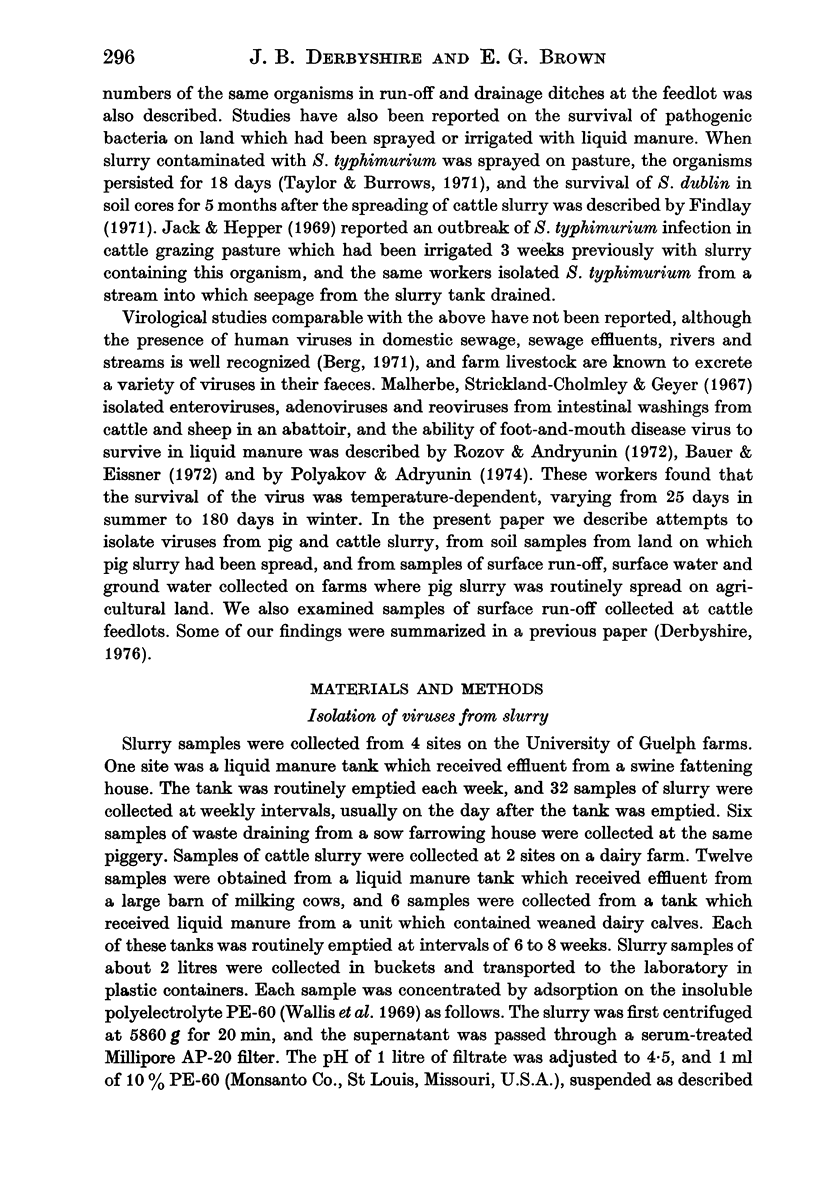
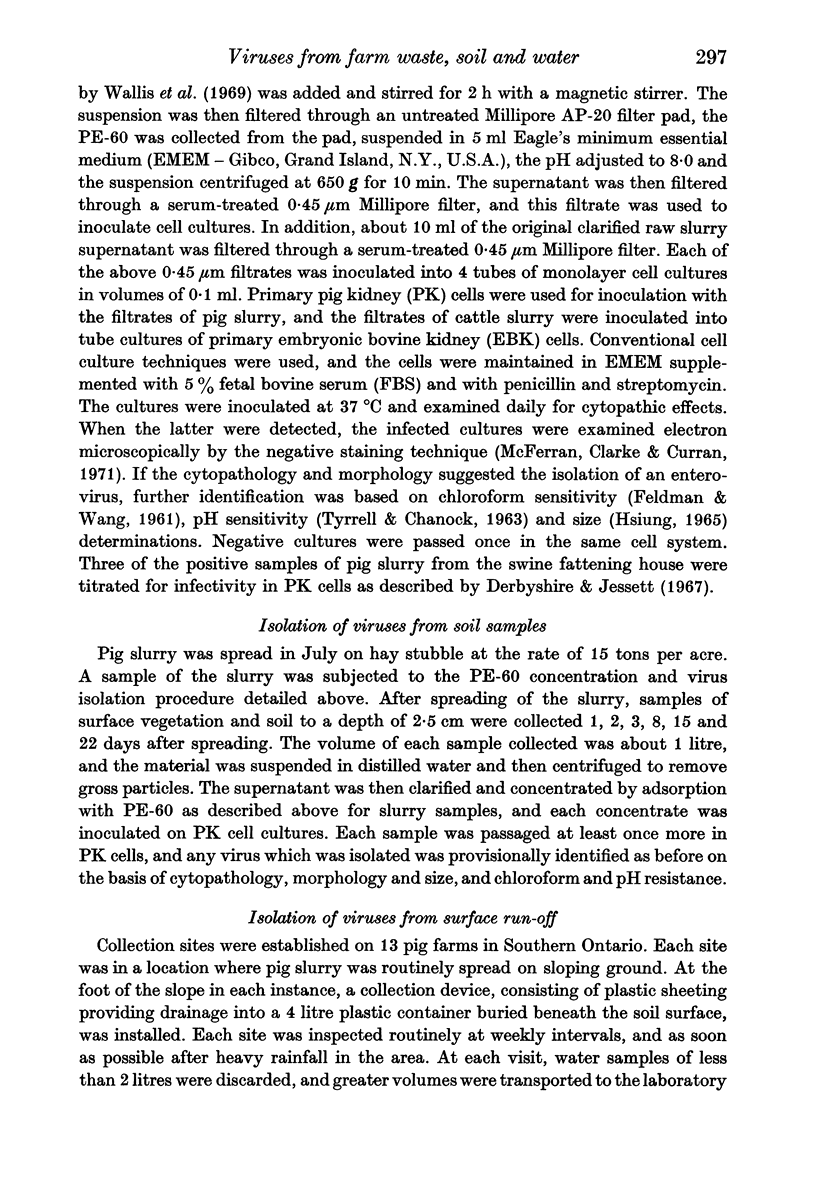
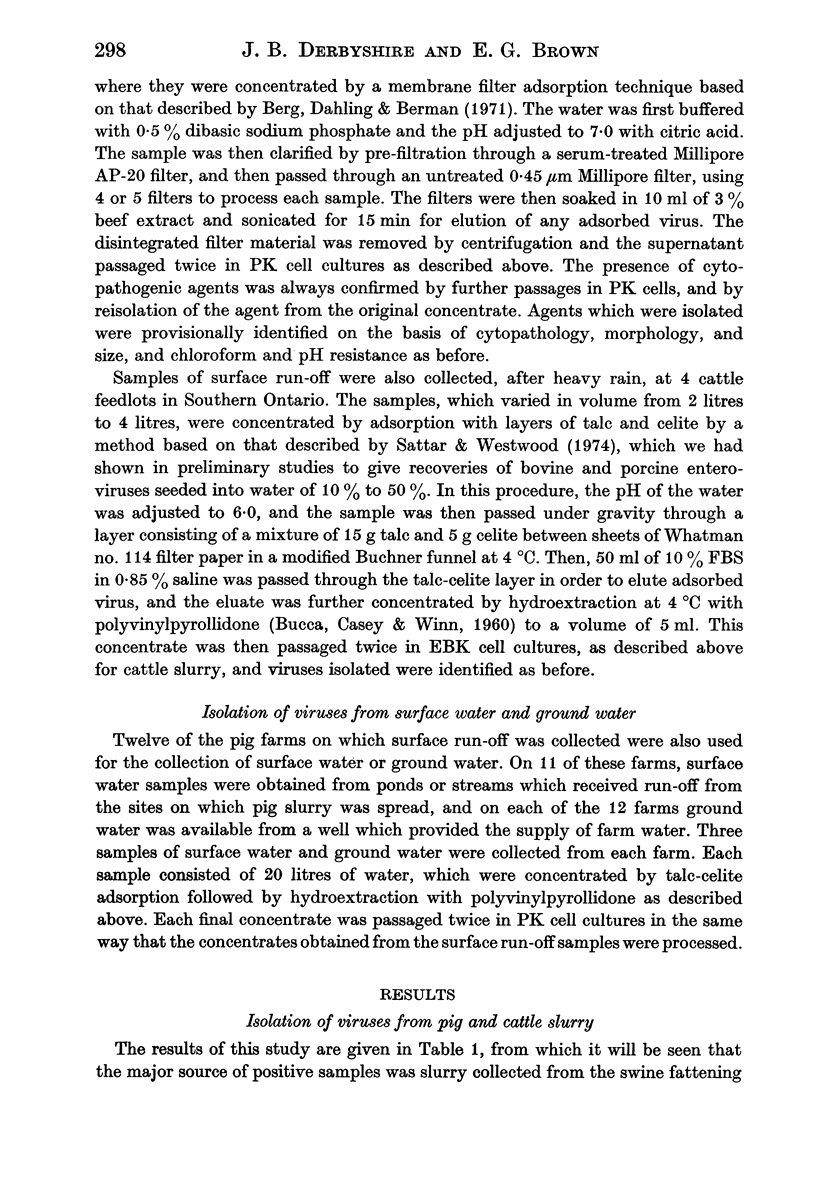
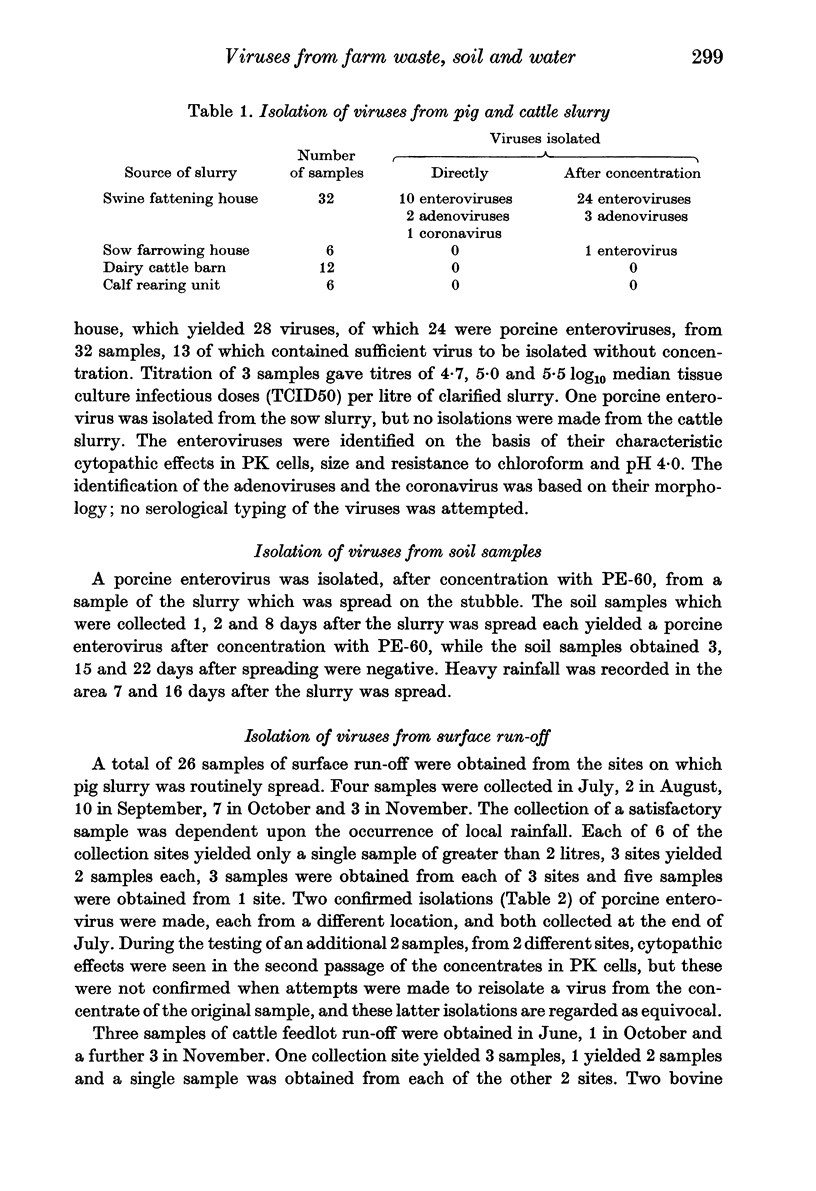

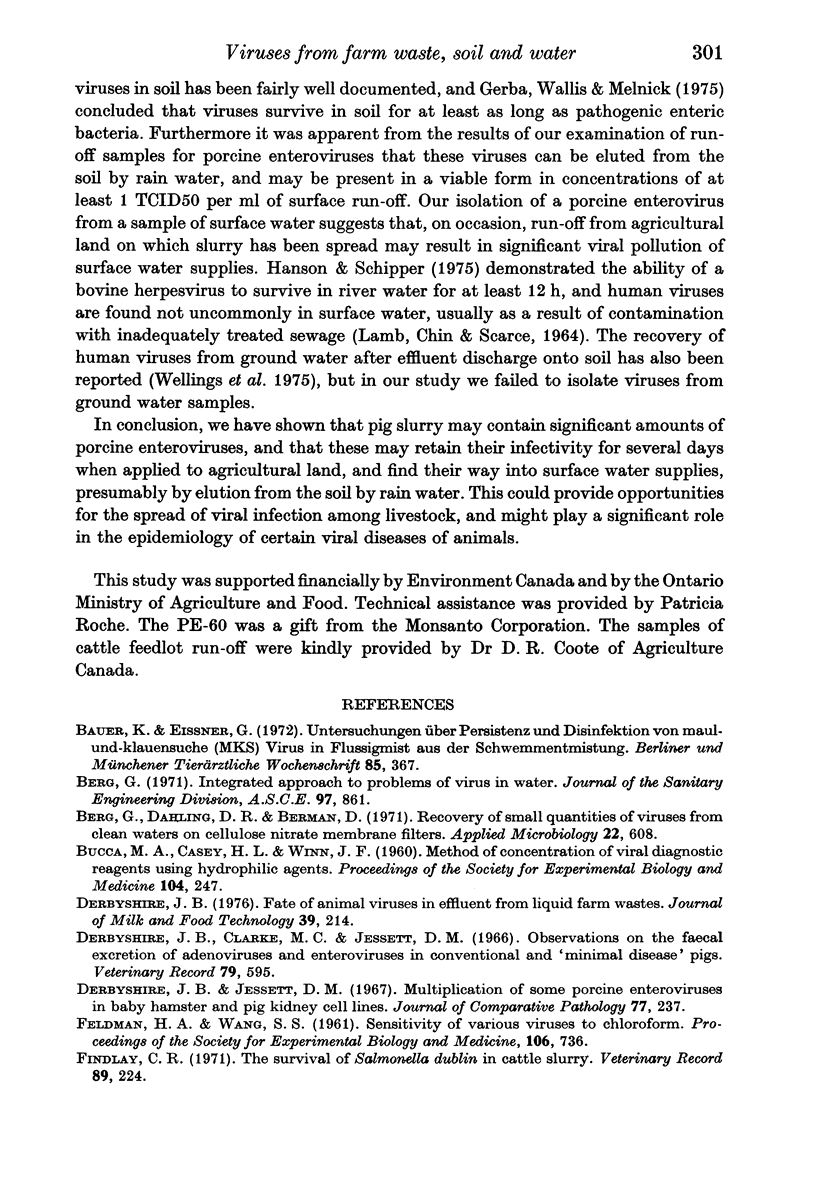
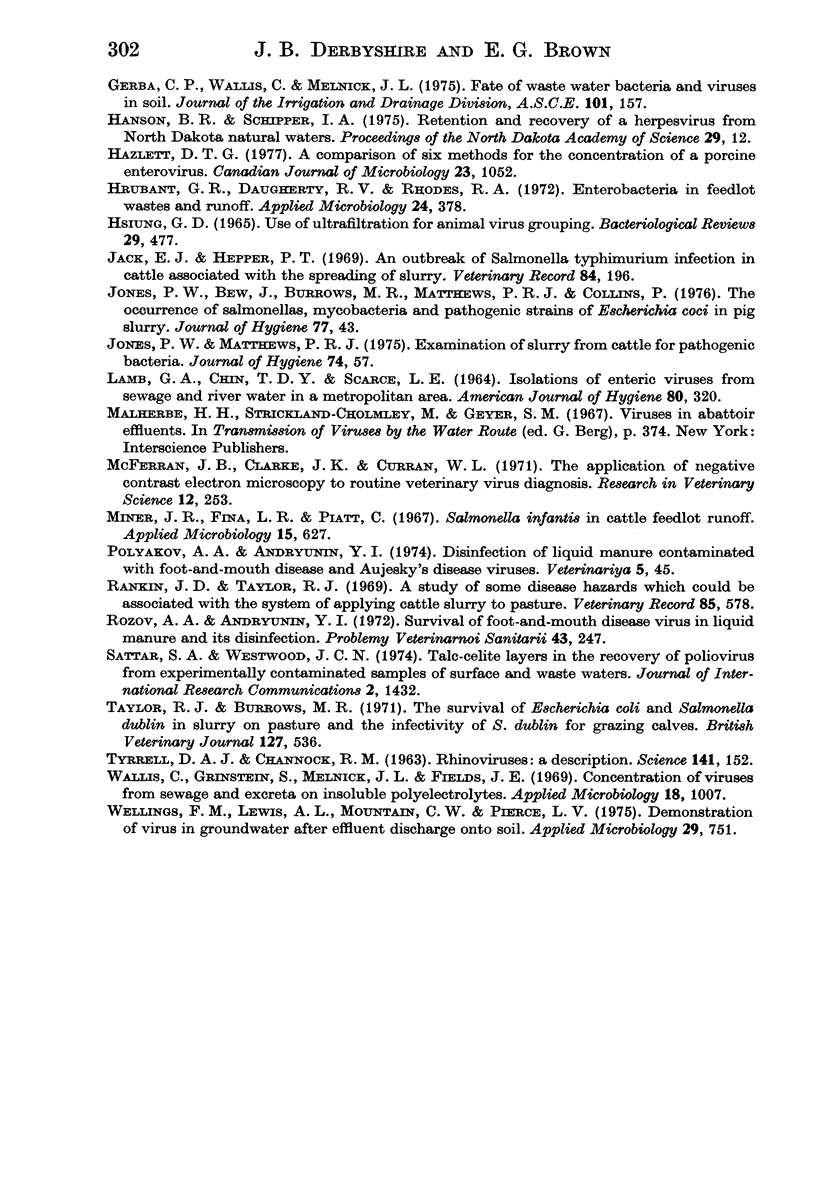
Selected References
These references are in PubMed. This may not be the complete list of references from this article.
- Bauer K., Eissner G. Untersuchungen über Persistenz und Desinfektion von Maul- und Klauenseuche (MKS)-Virus in Flüssigmist aus der Schwemmentmistung. Berl Munch Tierarztl Wochenschr. 1972 Oct 1;85(19):367–368. [PubMed] [Google Scholar]
- Berg G., Dahling D. R., Berman D. Recovery of small quantities of viruses from clean waters on cellulose nitrate membrane filters. Appl Microbiol. 1971 Oct;22(4):608–614. doi: 10.1128/am.22.4.608-614.1971. [DOI] [PMC free article] [PubMed] [Google Scholar]
- Derbyshire J. B., Jessett D. M. Multiplication of some porcine enteroviruses in baby hamster and pig kidney cell lines. J Comp Pathol. 1967 Jul;77(3):237–243. doi: 10.1016/0021-9975(67)90032-1. [DOI] [PubMed] [Google Scholar]
- FELDMAN H. A., WANG S. S. Sensitivity of various viruses to chloroform. Proc Soc Exp Biol Med. 1961 Apr;106:736–738. doi: 10.3181/00379727-106-26459. [DOI] [PubMed] [Google Scholar]
- Findlay C. R. The survival of Salmonella dublin in cattle slurry. Vet Rec. 1971 Aug 21;89(8):224–225. doi: 10.1136/vr.89.8.224. [DOI] [PubMed] [Google Scholar]
- Hazlett D. T. A comparison of six methods for the concentration of a porcine enterovirus. Can J Microbiol. 1977 Aug;23(8):1052–1058. doi: 10.1139/m77-157. [DOI] [PubMed] [Google Scholar]
- Hrubant G. R., Daugherty R. V., Rhodes R. A. Enterobacteria in feedlot waste and runoff. Appl Microbiol. 1972 Sep;24(3):378–383. doi: 10.1128/am.24.3.378-383.1972. [DOI] [PMC free article] [PubMed] [Google Scholar]
- Jack E. J., Hepper P. T. An outbreak of Salmonella typhimurium infection in cattle associated with the spreading of slurry. Vet Rec. 1969 Feb 22;84(8):196–199. doi: 10.1136/vr.84.8.196. [DOI] [PubMed] [Google Scholar]
- Jones P. W., Bew J., Burrows M. R., Matthews P. R., Collins P. The occurrence of salmonellas, mycobacteria and pathogenic strains of Escherichia coli in pig slurry. J Hyg (Lond) 1976 Aug;77(1):43–50. doi: 10.1017/s0022172400055492. [DOI] [PMC free article] [PubMed] [Google Scholar]
- Jones P. W., Matthews P. R. Examination of slurry from cattle for pathogenic bacteria. J Hyg (Lond) 1975 Feb;74(1):57–64. doi: 10.1017/s0022172400046714. [DOI] [PMC free article] [PubMed] [Google Scholar]
- LAMB G. A., CHIN T. D., SCARCE L. E. ISOLATIONS OF ENTERIC VIRUSES FROM SEWAGE AND RIVER WATER IN A METROPOLITAN AREA. Am J Hyg. 1964 Nov;80:320–327. doi: 10.1093/oxfordjournals.aje.a120482. [DOI] [PubMed] [Google Scholar]
- McFerran J. B., Clarke J. K., Curran W. L. The application of negative contrast electron microscopy to routine veterinary virus diagnosis. Res Vet Sci. 1971 May;12(3):253–257. [PubMed] [Google Scholar]
- Miner J. R., Fina L. R., Piatt C. Salmonella infantis in cattle feedlot runoff. Appl Microbiol. 1967 May;15(3):627–628. doi: 10.1128/am.15.3.627-628.1967. [DOI] [PMC free article] [PubMed] [Google Scholar]
- Rankin J. D., Taylor R. J. A study of some disease hazards which could be associated with the system of applying cattle slurry to pasture. Vet Rec. 1969 Nov 22;85(21):578–581. doi: 10.1136/vr.85.21.578. [DOI] [PubMed] [Google Scholar]
- TYRRELL D. A., CHANOCK R. M. Rhinoviruses: a description. Science. 1963 Jul 12;141(3576):152–153. doi: 10.1126/science.141.3576.152. [DOI] [PubMed] [Google Scholar]
- Taylor R. J., Burrows M. R. The survival of Escherichia coli and Salmonella dublin in slurry on pasture and the infectivity of S. dublin for grazing calves. Br Vet J. 1971 Nov;127(11):536–543. doi: 10.1016/s0007-1935(17)37287-1. [DOI] [PubMed] [Google Scholar]
- Wallis C., Grinstein S., Melnick J. L., Fields J. E. Concentration of viruses from sewage and excreta on insoluble polyelectrolytes. Appl Microbiol. 1969 Dec;18(6):1007–1014. doi: 10.1128/am.18.6.1007-1014.1969. [DOI] [PMC free article] [PubMed] [Google Scholar]
- Wellings F. M., Lewis A. L., Mountain C. W., Pierce L. V. Demonstration of virus in groundwater after effluent discharge onto soil. Appl Microbiol. 1975 Jun;29(6):751–757. doi: 10.1128/am.29.6.751-757.1975. [DOI] [PMC free article] [PubMed] [Google Scholar]


